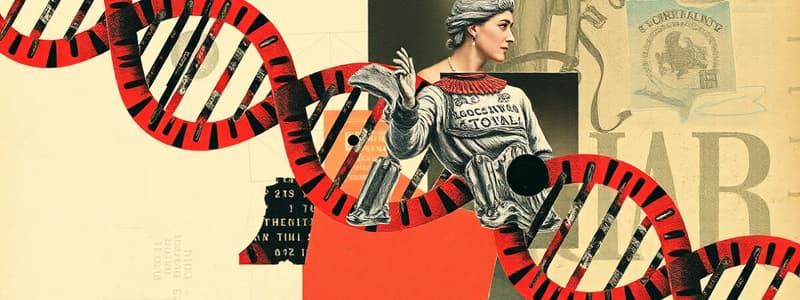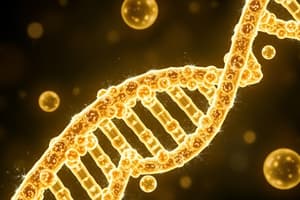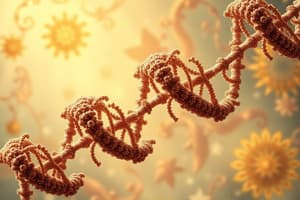Podcast
Questions and Answers
What is required for the synthesis of the leading strand during DNA replication?
What is required for the synthesis of the leading strand during DNA replication?
- Multiple DNA polymerases
- A single RNA primer (correct)
- A series of RNA primers
- No RNA primer
What enzyme is specifically responsible for synthesizing the RNA primer on the lagging strand template?
What enzyme is specifically responsible for synthesizing the RNA primer on the lagging strand template?
- DNA gyrase
- DNA ligase
- DNA polymerase III
- DNA primase (correct)
Which enzyme is responsible for joining Okazaki fragments during DNA replication?
Which enzyme is responsible for joining Okazaki fragments during DNA replication?
- DNA gyrase
- DNA ligase (correct)
- DNA polymerase I
- DNA helicase
What direction does DNA polymerase III synthesize the leading strand?
What direction does DNA polymerase III synthesize the leading strand?
What happens to the RNA primer once the DNA polymerase I replaces it with DNA nucleotides?
What happens to the RNA primer once the DNA polymerase I replaces it with DNA nucleotides?
How are the Okazaki fragments synthesized on the lagging strand?
How are the Okazaki fragments synthesized on the lagging strand?
Which activity of DNA polymerase I is responsible for extending the newly formed DNA strand?
Which activity of DNA polymerase I is responsible for extending the newly formed DNA strand?
What structure is left between two adjacent Okazaki fragments after RNA primer replacement?
What structure is left between two adjacent Okazaki fragments after RNA primer replacement?
What is the role of DNA ligase in DNA replication?
What is the role of DNA ligase in DNA replication?
Where does the termination of DNA replication occur?
Where does the termination of DNA replication occur?
What is the function of the Ter-Tus complex in DNA replication?
What is the function of the Ter-Tus complex in DNA replication?
How are the Okazaki fragments processed during DNA replication?
How are the Okazaki fragments processed during DNA replication?
What is the role of Pol δ during DNA replication?
What is the role of Pol δ during DNA replication?
What role does Topoisomerase IV play in the termination of DNA replication?
What role does Topoisomerase IV play in the termination of DNA replication?
Which statement about the replisome is accurate?
Which statement about the replisome is accurate?
What initiates the synthesis of Okazaki fragments on the lagging strand?
What initiates the synthesis of Okazaki fragments on the lagging strand?
Which components are key proteins associated with the replisome during DNA replication?
Which components are key proteins associated with the replisome during DNA replication?
What is the function of RNase H in Okazaki fragment processing?
What is the function of RNase H in Okazaki fragment processing?
What mechanism allows the lagging-strand polymerase to synthesize Okazaki fragments efficiently?
What mechanism allows the lagging-strand polymerase to synthesize Okazaki fragments efficiently?
Which protein is involved in removing RPA to allow FEN1 to cut off the flap during Okazaki fragment processing?
Which protein is involved in removing RPA to allow FEN1 to cut off the flap during Okazaki fragment processing?
What is the primary function of PCNA in the elongation phase of DNA replication?
What is the primary function of PCNA in the elongation phase of DNA replication?
At which stage of DNA replication is the end replication problem most significant?
At which stage of DNA replication is the end replication problem most significant?
What is the significance of the single-stranded overhang at the 5’ ends of newly synthesized DNA strands?
What is the significance of the single-stranded overhang at the 5’ ends of newly synthesized DNA strands?
Which enzyme is primarily responsible for synthesizing telomeric DNA in eukaryotes?
Which enzyme is primarily responsible for synthesizing telomeric DNA in eukaryotes?
Flashcards
Leading strand synthesis
Leading strand synthesis
Continuous synthesis of DNA toward the replication fork.
Lagging strand synthesis
Lagging strand synthesis
Discontinuous synthesis of DNA in short fragments (Okazaki fragments).
Okazaki fragments
Okazaki fragments
Short DNA fragments synthesized on the lagging strand during DNA replication.
DNA polymerase I
DNA polymerase I
Signup and view all the flashcards
DNA ligase
DNA ligase
Signup and view all the flashcards
DNA gyrase
DNA gyrase
Signup and view all the flashcards
RNA primer
RNA primer
Signup and view all the flashcards
Semi-discontinuous replication
Semi-discontinuous replication
Signup and view all the flashcards
What does DNA ligase do?
What does DNA ligase do?
Signup and view all the flashcards
What is the function of the Tus protein in DNA replication?
What is the function of the Tus protein in DNA replication?
Signup and view all the flashcards
What are catenanes?
What are catenanes?
Signup and view all the flashcards
What is the replisome?
What is the replisome?
Signup and view all the flashcards
Why is lagging strand synthesis discontinuous?
Why is lagging strand synthesis discontinuous?
Signup and view all the flashcards
What is the function of DNA polymerase I?
What is the function of DNA polymerase I?
Signup and view all the flashcards
What is the role of the primase in DNA replication?
What is the role of the primase in DNA replication?
Signup and view all the flashcards
How does the replisome move along the DNA?
How does the replisome move along the DNA?
Signup and view all the flashcards
PCNA
PCNA
Signup and view all the flashcards
RPA
RPA
Signup and view all the flashcards
Pol α / Primase
Pol α / Primase
Signup and view all the flashcards
Pol ε
Pol ε
Signup and view all the flashcards
Pol δ
Pol δ
Signup and view all the flashcards
RNase H
RNase H
Signup and view all the flashcards
FEN1
FEN1
Signup and view all the flashcards
Study Notes
DNA Replication
-
DNA replication is the process where DNA makes a copy of itself.
-
Three models for DNA replication were proposed:
- Semiconservative: Each new DNA molecule is made of one original strand and one new strand.
- Conservative: One new DNA molecule retains both original strands, and one new DNA molecule contains two new strands.
- Dispersive: Original and new DNA segments are interspersed in both new strands.
-
Meselson and Stahl's experiment provided evidence that the semiconservative model is correct.
- Bacteria were grown in a medium containing a heavy isotope of nitrogen (15N).
- The DNA was extracted and its density was measured.
- The results of successive generations matched the semiconservative model's predictions.
DNA Polymerase
-
Enzymes that catalyze the polymerization of nucleotide precursors (deoxyribonucleotides)
-
In 1955, Arthur Kornberg identified these enzymes.
-
Found in prokaryotes and eukaryotes.
-
DNA polymerase III is the enzyme involved in replication.
-
DNA is copied in a 5' to 3' direction on the template strand
-
Leading strand is synthesized continuously.
-
Lagging strand is synthesized discontinuously (Okazaki fragments)
Mechanism of DNA Elongation
-
At the growing end of the DNA chain, DNA polymerase forms a phosphodiester bond between the 3'-OH of the last nucleotide and the 5' phosphate of a dNTP
-
In each step, polymerase finds the correct dNTP
-
Nucleotide addition is rapid in prokaryotes ( ~ 850 per second).
-
High accuracy, low error frequency.
Mechanism of DNA Replication
- Initiation is directed by a DNA sequence called the replicator.
- The initiation of replication in a circular chromosome has a specific region call oriC
- E.coli initiator protein DnaA
- E.coli helicase (DnaB) and helicase loader (DnaC) are recruited.
- Once the DNA is unwound, a replication bubble forms.
- Replication forks move in opposite directions.
Termination of Replication
- Termination occurs at a specific region of the DNA termed the Ter region.
- Tus proteins (terminus utilization substances) bind to the Ter region.
- The Ter-Tus complex halts the replication fork progression.
Replication Bubble
- The segment of unwound DNA resulting from the separation of DNA stands during initiation of replication.
- The replication forks move in opposite directions away from the origin of replication.
Rolling Circle Replication
- Replication that produces linear DNA from a circular template.
- A nick is created in one strand of the double helix.
- The displaced strand is used as a template to initiate the synthesis of a complementary strand.
DNA Replication in Eukaryotes
- Eukaryotes have linear chromosomes & multiple origins of replication
- Relatively slower than prokaryotes, due to multiple origins of replication.
- The end replication problem: The inability to completely replicate the ends of linear chromosomes.
- Telomerase: An enzyme that adds telomeric repeats to the ends of chromosomes, solving the end-replication problem. Telomerase RNA provides a template for synthesis.
Okazaki Fragments
- Short DNA fragments made during lagging strand synthesis.
- These fragments are later joined together by DNA ligase.
Eukaryotic DNA Replication
- Multiple origins of replication are found in eukaryotic chromosomes to speed up the process.
- Different DNA polymerases participate.
- Elongation uses leading and lagging strands like prokaryotes.
- Post-replication processing includes removal of RNA primers and joining of Okazaki fragments by special enzymes.
- There are specific mechanisms to cope with the end-replication problem in linear chromosomes.
Studying That Suits You
Use AI to generate personalized quizzes and flashcards to suit your learning preferences.
Related Documents
Description
Test your understanding of DNA replication processes, including the semiconservative, conservative, and dispersive models. Explore the significance of Meselson and Stahl's experiment, and learn about DNA polymerases and their functions. This quiz covers key concepts relevant for biology students.




